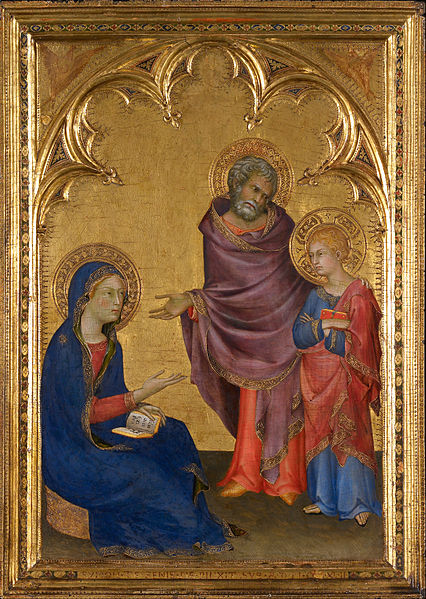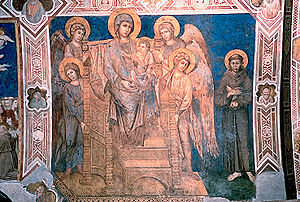Cimabue Biograhpy (Bencivieni di Pepo )-Italian Painter:
Cimabue (1240–1302), also known as Bencivieni di Pepo or in modern Italian, Benvenuto di Giuseppe, was a Florentine painter and creator of mosaics.
Cimabue is generally regarded as one of the first great Italian painters to break away from the Italo-Byzantine style, although he still relied on Byzantine models. The art of this period comprised scenes and forms that appeared relatively flat and highly stylized. Cimabue was a pioneer in the move towards naturalism, as his figures were depicted with rather more lifelike proportions and shading. Even though he was a pioneer in that move, his Maestà paintings show Medieval techniques and characteristics.
According to Giorgio Vasari, he was the teacher of Giotto, considered the first great artist of the Italian Renaissance.
Basilica di Santa Croce, Florence.Owing to little surviving documentation, not much is known about Cimabue's life. He was born in Florence and died in Pisa. His career was described in Giorgio Vasari's Lives of the Most Excellent Painters, Sculptors, and Architects. Although it is one of the few early records about him, its accuracy is uncertain.
Cimabue perhaps trained in Florence under unknown masters culturally connected to Byzantine art. However, his first attributed work, the Crucifixion in the church of San Domenico in Arezzo (assigned to him by Italian art historian Pietro Toesca and dated to around 1270), he departed from the Byzantine style. His style was at the time more reminiscent of works such as the Christus patiens (c. 1250) by Giunta Pisano, although Cimabue's Christ is more bent and the clothes have the golden striations introduced by Coppo di Marcovaldo.
Fresco in the Lower Basilica of Assisi.Around 1272 he is documented in Rome. A little later, he made another Crucifixion for the Florentine church of Santa Croce (incidentally: damaged by the 1966 Arno River flood). This is a larger and more evoluted work than that in Arezzo, with traces of naturalism perhaps inspired by Nicola Pisano's works. In the same period (c. 1280) he painted the Maestà now at the Louvre Museum, originally in the church of San Francesco at Pisa. This work established a style which was followed by numerous artists after him, including Duccio di Buoninsegna in his Rucellai Madonna (once wrongly attributed to Cimabue), as well as Giotto himself. Other works dating to this period, in which the influence of his pupil Giotto becomes manifest, include a Flagellation , mosaics for the Baptistery of Florence (now largely restored), the Maestà at the Santa Maria dei Servi in Bologna and the Madonna in the Pinacoteca of Castelfiorentino. A workshop painting, perhaps assignable to a slightly later period, is the Maestà with Saints Francis and Dominic now at the Uffizi.
During the pontificate of Pope Nicholas IV, the first Franciscan pope, Cimabue worked at Assisi. His call was perhaps due to the fame he gained in Rome in 1272, although no works from his stay there are known. At Assisi, in the transept of the Lower Basilica of San Francesco, he frescoed a Madonna with Child Enthroned, Four Angels and St. Francis; the left part of the work is missing, and perhaps showed St. Antony of Padua. The authorship of the painting has been recently disputed for technical and stylistic reasons, however. Cimabue was subsequently commissioned the decoration of the apse and the transept of the Upper Basilica of Assisi, in the same period in which Roman artists were frescoing the nave. The cycle comprises scenes from the Gospels, the life of Mary and of St. Peter and St. Paul, and is today in poor condition due to the oxidation of the brighter colors.
The Maestà of Santa Trinita, originally painted for the church of Santa Trinita in Florence dates to c. 1290-1300. It is now at the Uffizi Gallery. The softer expression of the characters suggests that it was influenced by Giotto, who was by then already active as a solo artist. Cimabue spent the period from 1301 to 1302 in Pisa, where, together with collaborators, he executed the apse mosaic for the city's cathedral. He died in 1302. (Cimabue Biograhpy-Bencivieni di Pepo-Painer)
Refer to: http://en.wikipedia.org/wiki/Cimabue
Edited by Kevin from Xiamen Romandy Art Limited.
(Xiamen Romandy Art is a professional oil paintings supplier from China. If you want to convert your photos into high quality oil paintings, or you want the masterpiece oil painting reproductions, please don's hesitate to contact with us.)
Romandy Art Website: http://www.oilpaintingcentre.com
Tags: Cimabue Biograhpy (Bencivieni di Pepo )-Italian Oil Painting Artist.
|